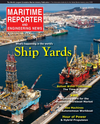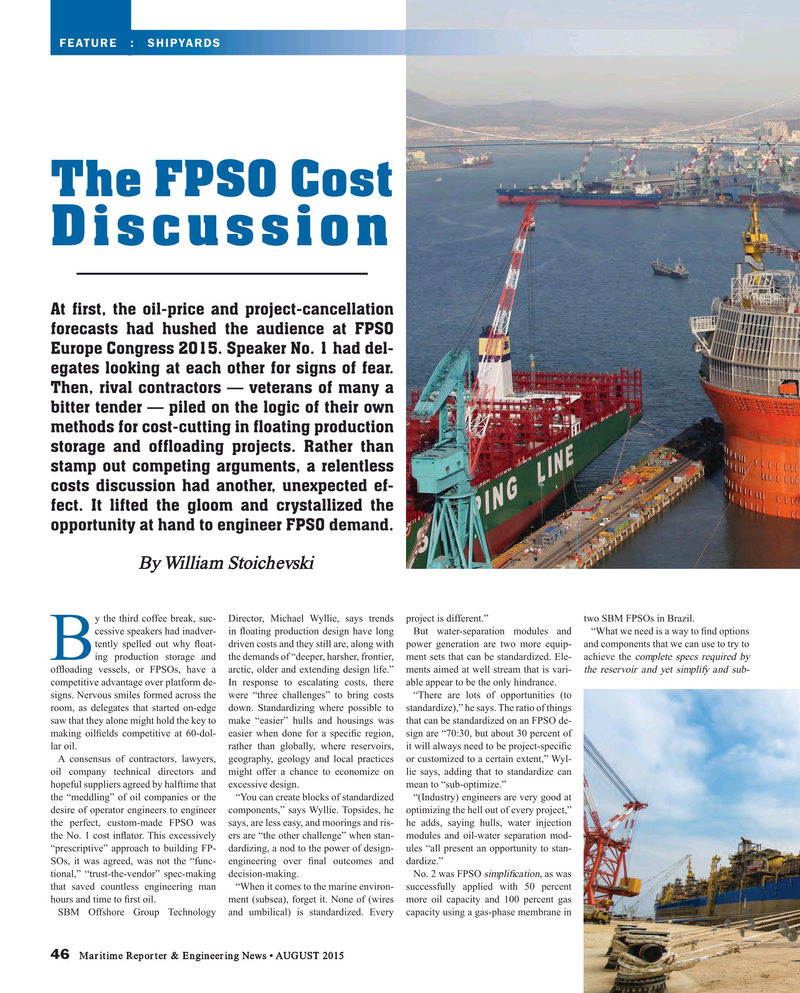
Page 46: of Maritime Reporter Magazine (August 2015)
Shipyard Edition
Read this page in Pdf, Flash or Html5 edition of August 2015 Maritime Reporter Magazine
FEATURE : SHIPYARDS
The FPSO Cost
Discussion
At ? rst, the oil-price and project-cancellation forecasts had hushed the audience at FPSO
Europe Congress 2015. Speaker No. 1 had del- egates looking at each other for signs of fear.
Then, rival contractors — veterans of many a bitter tender — piled on the logic of their own methods for cost-cutting in ? oating production storage and of? oading projects. Rather than stamp out competing arguments, a relentless costs discussion had another, unexpected ef- fect. It lifted the gloom and crystallized the opportunity at hand to engineer FPSO demand.
By William Stoichevski y the third coffee break, suc- Director, Michael Wyllie, says trends project is different.” two SBM FPSOs in Brazil.
cessive speakers had inadver- in ? oating production design have long But water-separation modules and “What we need is a way to ? nd options tently spelled out why ? oat- driven costs and they still are, along with power generation are two more equip- and components that we can use to try to
Bing production storage and the demands of “deeper, harsher, frontier, ment sets that can be standardized. Ele- achieve the complete specs required by of? oading vessels, or FPSOs, have a arctic, older and extending design life.” ments aimed at well stream that is vari- the reservoir and yet simplify and sub- competitive advantage over platform de- In response to escalating costs, there able appear to be the only hindrance.
signs. Nervous smiles formed across the were “three challenges” to bring costs “There are lots of opportunities (to room, as delegates that started on-edge down. Standardizing where possible to standardize),” he says. The ratio of things saw that they alone might hold the key to make “easier” hulls and housings was that can be standardized on an FPSO de- making oil? elds competitive at 60-dol- easier when done for a speci? c region, sign are “70:30, but about 30 percent of lar oil. rather than globally, where reservoirs, it will always need to be project-speci? c
A consensus of contractors, lawyers, geography, geology and local practices or customized to a certain extent,” Wyl- oil company technical directors and might offer a chance to economize on lie says, adding that to standardize can hopeful suppliers agreed by halftime that excessive design. mean to “sub-optimize.” the “meddling” of oil companies or the “You can create blocks of standardized “(Industry) engineers are very good at desire of operator engineers to engineer components,” says Wyllie. Topsides, he optimizing the hell out of every project,” the perfect, custom-made FPSO was says, are less easy, and moorings and ris- he adds, saying hulls, water injection the No. 1 cost in? ator. This excessively ers are “the other challenge” when stan- modules and oil-water separation mod- “prescriptive” approach to building FP- dardizing, a nod to the power of design- ules “all present an opportunity to stan-
SOs, it was agreed, was not the “func- engineering over ? nal outcomes and dardize.” tional,” “trust-the-vendor” spec-making decision-making. No. 2 was FPSO simpli? cation, as was that saved countless engineering man “When it comes to the marine environ- successfully applied with 50 percent hours and time to ? rst oil. ment (subsea), forget it. None of (wires more oil capacity and 100 percent gas
SBM Offshore Group Technology and umbilical) is standardized. Every capacity using a gas-phase membrane in 46 Maritime Reporter & Engineering News • AUGUST 2015
MR #8 (42-49).indd 46 MR #8 (42-49).indd 46 7/30/2015 9:54:30 AM7/30/2015 9:54:30 AM

 45
45

 47
47
